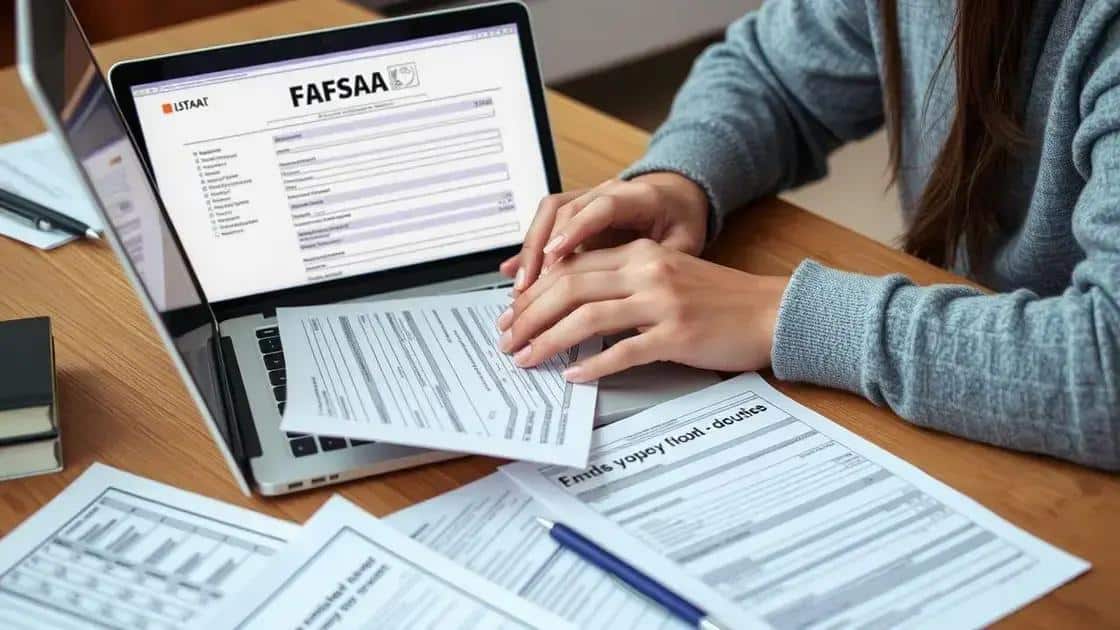How to apply for federal student aid (FAFSA) effectively

To apply for federal student aid (FAFSA), complete the online application early, ensure all information is accurate, and explore various funding options, including grants, loans, and scholarships.
Applying for federal student aid (FAFSA) can feel overwhelming, but it doesn’t have to be. With the right steps, you can simplify the process and secure the funding needed for your education. Ever wondered what the first steps are? Let’s explore together.
Understanding FAFSA: What You Need to Know
Understanding FAFSA is crucial for anyone seeking federal student aid. This application form unlocks various funding opportunities for your education. It’s important to grasp what FAFSA entails and how you can benefit from it.
What is FAFSA?
The Free Application for Federal Student Aid (FAFSA) is a form designed to determine your eligibility for federal student aid. This aid can include grants, work-study, and loans. Completing it opens doors to higher education financing options.
Eligibility Requirements
To qualify, you must meet certain criteria. Generally, you need to be:
- A U.S. citizen or an eligible noncitizen.
- Enrolled or accepted for enrollment in an eligible degree or certificate program.
- Maintaining satisfactory academic progress in college.
These basic requirements set the foundation for federal aid eligibility. Keep in mind that each aid program may have specific eligibility criteria.
Why You Should Apply
Applying for FAFSA is not just for those who need financial help. Many families mistakenly think they won’t qualify. However, securing even a small amount of aid can lessen your educational costs significantly.
Every year, billions of dollars in federal aid are available. It’s worth taking the time to fill out the application. Additionally, many states and colleges use the FAFSA results to award their aid.
When to Apply
Timeliness is key. The FAFSA opens each year on October 1. Here’s why timing matters:
- Funds are limited; applying early increases your chances of receiving aid.
- Some states have deadlines that are earlier than the federal deadline.
- Apply as soon as possible to maximize your financial aid options.
Being informed about the FAFSA process can help you navigate the financial aid landscape. Understanding the essentials will prepare you well. Ultimately, knowledge empowers you to make smarter decisions about funding your education.
Eligibility requirements for federal student aid
Understanding the eligibility requirements for federal student aid is essential for anyone planning to apply for assistance. Knowing these requirements can help you determine if you qualify for aid and how to proceed with your application.
Basic Qualifications
To be eligible for federal student aid, you need to meet several core criteria. First, you must be a U.S. citizen or an eligible noncitizen. This means you should hold a green card or have a suitable visa. Additionally, you must have a valid Social Security number. These basic qualifications are crucial for your application.
Enrollment Status
Your enrollment status plays a significant role in determining your eligibility. To qualify for federal aid, you should be enrolled or accepted for enrollment in an eligible degree or certificate program at a college, university, or vocational school. Whether you are attending full-time or part-time can also affect the type and amount of aid you receive.
- Full-time students often qualify for more aid.
- Part-time students may have limited options but can still receive assistance.
Understanding these factors makes it easier to navigate the FAFSA process and secure funding.
Academic Progress
Maintaining satisfactory academic progress is another critical eligibility requirement. This means you need to keep up with your coursework and meet your school’s academic standards. If you fail to do so, you may lose your eligibility for federal aid. Each school sets its criteria for academic progress, so it’s important to check with your institution.
Additional Considerations
There are some additional conditions that can impact your eligibility for certain types of aid. For example, if you have a drug conviction while receiving federal student aid, it could affect your eligibility. Being mindful of your responsibilities as a student can help keep you on track.
In summary, knowing the eligibility requirements for federal student aid helps you prepare for the application process. Make sure to review these guidelines carefully and be proactive as you plan your education funding.
Step-by-step guide to completing your FAFSA

Completing your FAFSA may seem daunting, but breaking it down into simple steps makes it easier. This step-by-step guide will help you navigate the application process smoothly.
Gather Your Documents
Before you start, collect all necessary documents. You will need:
- Your Social Security number.
- Your driver’s license or state ID.
- Tax returns from the previous year and any W-2 forms.
Having these documents ready will streamline the application process and save you time.
Go to the FAFSA Website
Visit the official FAFSA website at fafsa.gov. Create an account or log in if you already have one. Make sure to use a reliable internet connection to avoid disruptions while you are filling out the form.
Complete the Application
Now it’s time to fill out the application. Start with your name, date of birth, and other personal information. Be honest and accurate, as mistakes could delay your aid. Answer all questions thoroughly and follow the prompts carefully.
List Your Schools
You can list up to ten colleges or universities on your FAFSA. It’s beneficial to include schools you are considering, even if you haven’t applied yet. This way, they can review your application for financial aid once it is processed.
- Consider adding institutions with varying tuition costs to compare offers.
- Ensure that all listed schools are eligible for federal student aid.
After adding your schools, double-check that all information is correct before moving on.
Review and Submit
Before submitting your FAFSA, take a moment to review all entries. Look for errors or missing information. Once you are satisfied, submit your application. You will receive a confirmation after submission, so save this for your records.
Follow Up
After submitting, you should check back to ensure everything is processed correctly. You will receive a Student Aid Report (SAR) that summarizes your FAFSA information. Review it carefully for any discrepancies. If corrections are needed, you can easily update your FAFSA online.
By following these steps, completing your FAFSA becomes a manageable task. Remember to stay organized and proactive throughout the entire process.
Common mistakes to avoid during the FAFSA process
Avoiding common mistakes during the FAFSA process can significantly enhance your chances of securing federal student aid. Many applicants make minor errors that delay their application or reduce their aid options, so it’s essential to be aware of these pitfalls.
Incorrect Social Security Numbers
One of the most common mistakes is entering an incorrect Social Security number. This number must match your official documents. An error here can complicate your application and delay your eligibility for aid.
Omitting Schools
Another frequent mistake is failing to list all the schools you are interested in. You can include up to ten schools on your FAFSA. It’s crucial to add each institution where you plan to apply, as schools use this information to determine your financial aid packages.
- Double-check the names of each school.
- Ensure you are considering schools that are eligible for federal aid.
- Keep your options open by listing diverse schools.
This way, you maximize your potential for receiving aid offers from various institutions.
Neglecting to Sign the FAFSA
Always remember to sign your FAFSA. Failing to sign will result in your application being rejected. Both the student and, if applicable, one parent must sign the form. Make sure to use an FSA ID to electronically sign your application.
Missing Deadlines
Each state and school has its deadlines for FAFSA submission. Missing these deadlines can lead to the loss of potential aid. Stay organized by keeping track of important dates and aiming to submit your application as early as possible.
- Know the federal deadline: typically June 30 for the academic year.
- Check state and school-specific deadlines, as they can vary.
Being mindful of these common mistakes helps streamline your FAFSA process and improves the likelihood of receiving the aid you need.
Using Incorrect Income Information
Finally, many applicants do not report their income correctly. Use the correct tax information from the previous year, and ensure it matches the IRS data. If your income has changed significantly, be prepared to provide an explanation to the school’s financial aid office.
By recognizing and avoiding these common errors, you can make your FAFSA submission smoother and more effective, helping you secure the funding you need for your educational journey.
Tips for maximizing your federal aid options
Maximizing your federal aid options is vital for making education more affordable. With the right approach, you can ensure that you receive as much assistance as possible. Here are some effective tips to help you along the way.
Complete Your FAFSA Early
One of the best ways to maximize your federal aid is by completing your FAFSA as early as possible. Submitting your application early can increase your chances of receiving more aid. Federal and state funding can be limited, so being proactive can pay off.
Research State and Institutional Aid
Don’t just rely on federal aid; also explore state-specific and institutional aid options. Many states offer additional financial aid that requires separate applications, so be sure to check the deadlines and requirements for these programs. Institutions may also provide their own scholarships and grants, which can significantly reduce your costs.
- Visit your state’s education website for details on state aid.
- Check the financial aid office at your school for available scholarships.
- Consider varying your school choices; some may have better aid offers than others.
By broadening your search, you may uncover opportunities to save even more.
Understand the Types of Aid
Familiarize yourself with the different types of federal student aid available. There are grants, scholarships, work-study programs, and loans. Grants and scholarships do not need to be repaid, while loans do. Knowing the differences helps you choose the best mix of aid to meet your needs.
Maintain Good Academic Standing
Many forms of federal aid require you to maintain satisfactory academic progress. This typically means keeping a certain GPA and completing a specific number of credit hours. Staying on top of your studies not only helps you maintain eligibility but may also qualify you for additional funding opportunities.
Communicate with Your Financial Aid Office
Your school’s financial aid office can be a valuable resource. They can help answer questions, provide insights about additional funding options, and guide you through the process. Regularly checking in can be beneficial, especially if your financial situation changes.
Being proactive and informed about your financial options is essential for maximizing your federal aid. By following these tips, you can make the most of the opportunities available to you and ease the financial burden of your education.
In summary, understanding how to apply for federal student aid, or FAFSA, is crucial for financing your education. By completing your application early, avoiding common mistakes, and researching all available aid options, you can maximize your potential funding. Always remember to stay in touch with your financial aid office, as they can provide important updates and support. With these strategies, you are on your way to making your educational dreams a reality!
FAQ – Frequently Asked Questions about Applying for Federal Student Aid (FAFSA)
What is FAFSA and why is it important?
FAFSA stands for Free Application for Federal Student Aid. It is crucial because it determines your eligibility for federal financial aid to help pay for college.
When should I complete my FAFSA application?
You should complete your FAFSA as early as possible after it opens on October 1 each year to maximize your chances of receiving aid.
What common mistakes should I avoid on my FAFSA?
Common mistakes include entering incorrect Social Security numbers, not signing the application, and missing deadlines.
How can I maximize my federal student aid?
Maximize your aid by completing the FAFSA early, exploring state and institutional aid, maintaining good academic standing, and keeping in touch with your financial aid office.





